Embracing technology: Maggie Grey
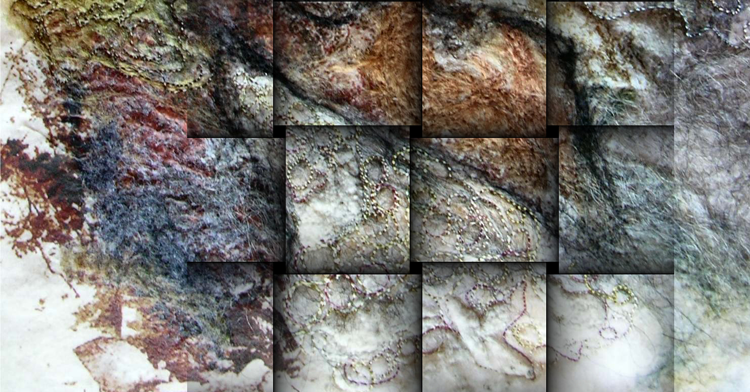
Maggie Grey is the editor of Workshop on the Web, a quarterly online journal containing step-by-step workshops by respected textile tutors. Prior to that, she was editor of Embroidery magazine. She is also a prominent textiles tutor and artist herself and has travelled extensively, teaching by invitation in Australia, New Zealand, the USA and Canada.
Maggie has been kind enough to provide this guest piece for TextileArtist.org about how computer textile design has featured heavily in her work as an artist since her training. Her devotion to technology also led to the creation of a well-loved resource for textile and fiber artists (Workshop on the Web). Maggie has impressive credentials, but what’s most inspiring is how she has harnessed them to produce a long-term business prospect for herself without losing her original passion for the creation of textile art and design.
The angel in the studio (or the devil in the detail)
I’m talking about the computer, of course, the necessary evil we all like to moan about. Great when it’s working (and I’m a devotee) but those black days when your web connection fails produce frustration on an epic scale. We can all see the advantages that networking brings but is it worth it? And can the image programs and apps really help us with the execution of our stitched pieces?
My life would have been very different without the influence of computers. Married to a ‘systems’ guy, we acquired an early Amstrad in the 1980s. ‘State of the Art’ stuff: a tiny (20mb) hard drive, single 5½” floppy disk, a book-sized modem and a steep learning curve. We used it to send files to the other members of Clive’s consultancy. With no web, no email, no attachments, data transfer was a tricky business involving protocols, handshakes and a lot of bad language.
However, I was attending a City & Guilds course in creative embroidery and rapidly came to see that many of the elements of pattern and design could be accomplished easily using a program called ‘GEM Paint’, part of the Amstrad basic suite. It didn’t matter that only 16 colours were available on the screen and we had a black-and-white printer. Much could be done with paints and crayons applied over the print. Early inkjets, when they arrived, were wonderfully receptive to discharge by bleach and water. There were mutterings about ‘cheating’ from the class but my tutor was all for experimentation and I was soon using my ‘computer art’ to inform my stitched pieces, even down to stitching into the prints themselves.
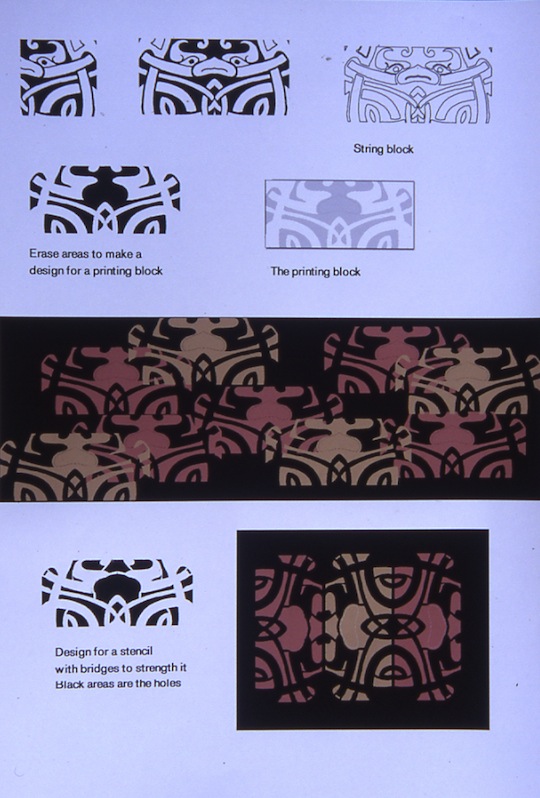
This early example of computer design by Val Campbell-Harding shows how a mono print could be used to make stencils and printing blocks.
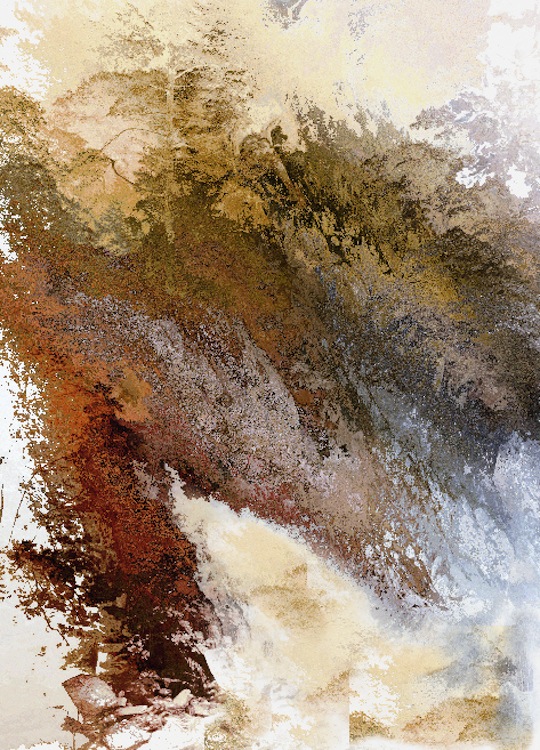
One of my early computer designs showing a black and white design, printed on to hand-made paper and colour, using inks and bleach.
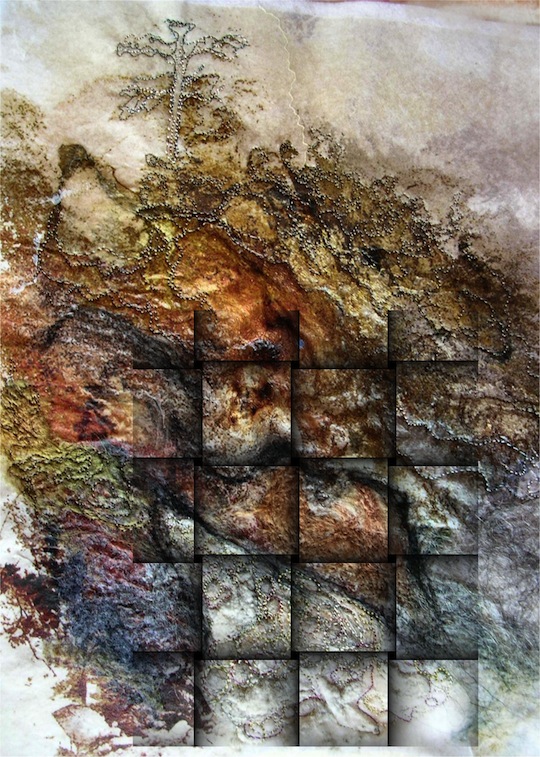
The print was then drawn into and areas cut and woven to mimic the effect of the weave filter. Finally it was placed on a firm backing and free machined.
Computer textile design
Post-C&G, I continued my love affair with textiles by attending further courses and joining an exhibiting group. Teaching followed on fairly naturally and soon I was receiving requests for courses on computer design.
My late, great, friend Val Campbell-Harding and I often worked together on design projects, Val working on a MAC and me on a PC (or IBM compatible). She suggested that we try running a residential course together with Val teaching MAC while Clive and I taught PC. Believe it or not, people would bring their desktop machines (laptops were yet to make an appearance) and we would plug in all the bits, load the software and get them all working. I needed Clive as the technical aspects of persuading a mouse to work with the program (a wonderful innovation called De Luxe Paint) were beyond me. He loves an IT challenge and acted as ‘techie’ for both Val and me. It was much easier when colleges such as Missenden Abbey and Urchfont Manor acquired computer suites and laptops.
Val and I taught many classes, expanding them to include practical sessions, working on printouts. Clive and I went on to teach all over the country, even running a course in Australia. Val initiated a society, the Computer Textile Design Group (www.ctdg.org.uk), which continues to this day. In time, the computer was accepted as a design tool, one among many available to textile artists, quilters and embroiderers.
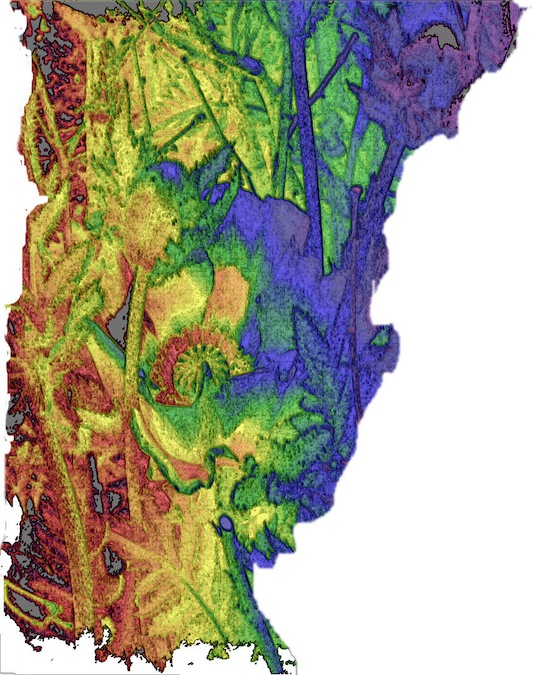
An experiment with a poppy. The photograph was taken into Adobe Photoshop
and an effect known as a Displacement map was used to alter colour and shape.
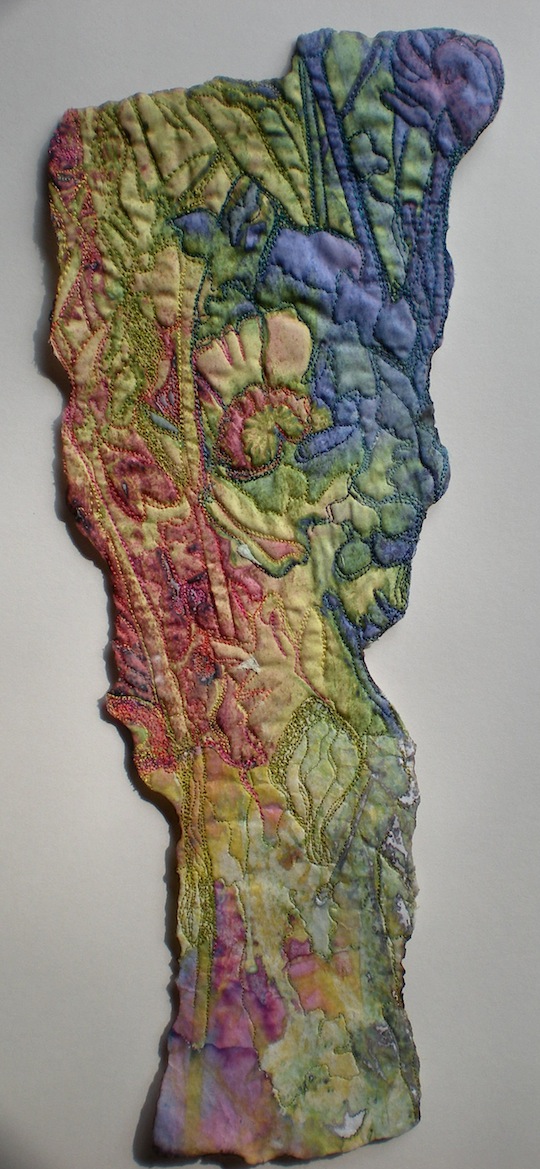
The above design printed on cotton and stitched.
The early days
Clive was always interested in all aspects of computing and, as he was thoroughly fed up with consultancy, decided that we should have a presence on the internet and see how we could expand the (exhausting) residential courses. In the 1990s, there were no ‘easy option’ ways of setting up a website so he spent the best £100 of his life on a distance learning course on HTML (web language). The wonderful Fiona Dix (www.TextileArts.net) was a patient and inspirational teacher and soon we had a website and a thriving distance learning business with both design and stitch on the syllabus.
We had students all over the world and they would send in their work for assessment. We had such a long waiting list that we decided to stop all the assessments and produce the lessons on a quarterly basis instead. Then it occurred to us to ask other tutors to write lessons and, twelve years ago, it turned into the internet magazine Workshop on the Web (www.workshopontheweb.com). With the addition of a section that tests new products (also written on a ‘how to’ basis) book reviews and news, it is enjoyed by thousands of people, all around the world. We aim for inspirational tutors and many well-known names write for us.
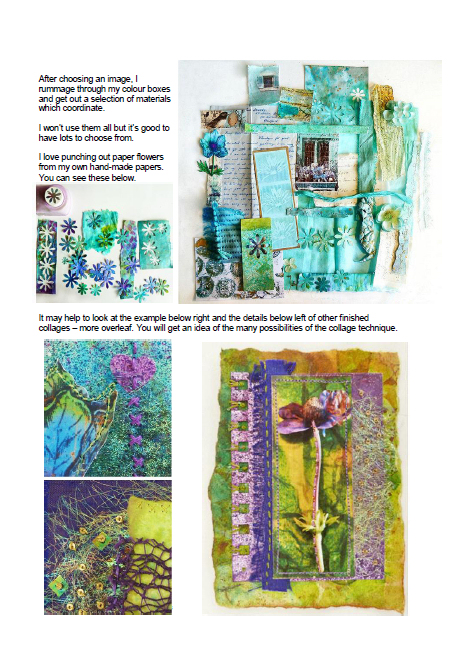
A screen shot from the latest issue of Workshop on the Web showing a page from an article by Linda Vincent on collage and stitch.
I have had (and am still having) a wonderful career in textiles, teaching all around the world, editing the Embroiderers’ Guild’s ‘Embroidery’ magazine, exhibiting, writing many books, both for B T Batsford (Anova) and my own publishing company D4Daisy Books Ltd (www.d4daisy.com). I really don’t think any of it would have been possible without computers and the web (and Clive, of course). Even my d4daisy books have online workshops!
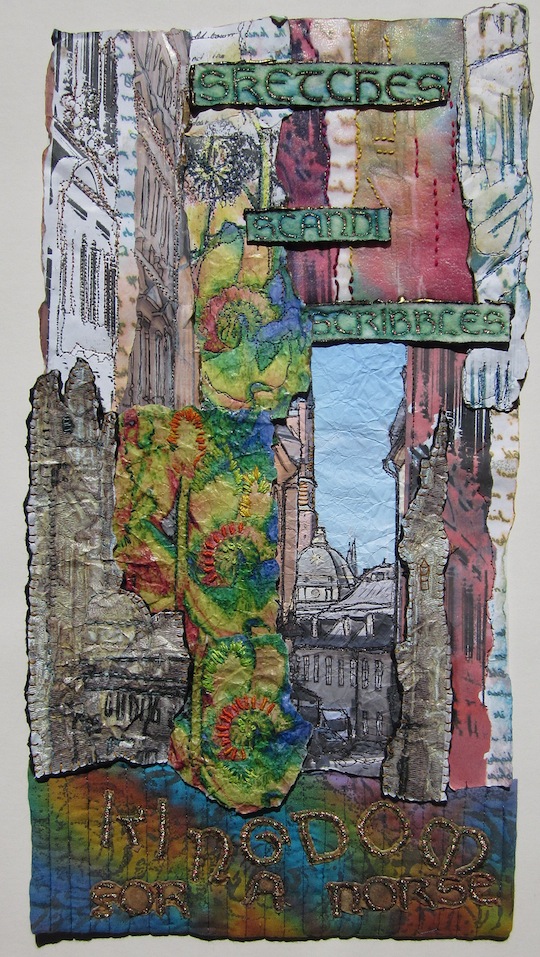
I often use a favourite design again in a different way. Here the poppy design provides continuity in a piece made to record a Scandinavian holiday. There were lots of poppies over there so it fitted well with the prints of places and views, I often stitch these ‘diary’ pieces on paper and protect them with acrylic wax.
Perhaps a final thought to sum it all up. Two years ago, I was very proud to be asked to send a piece of work to South Carolina for an exhibition curated by the amazing Susan Lenz. Entitled ‘Cyber Fyber’, it was all about the web and was shown online as a gallery tour in addition to the ‘on the ground’ exhibition. My piece was called ‘Binary Humanity’ and was all about the real people who use eyes to look at the screen and fingers to type. Cast paper hands and faces conveyed this on a background of metal and painted plastic. All around the edge are comments from my blog (www.magstitch.blogspot.com), left by people describing what the internet means to them.
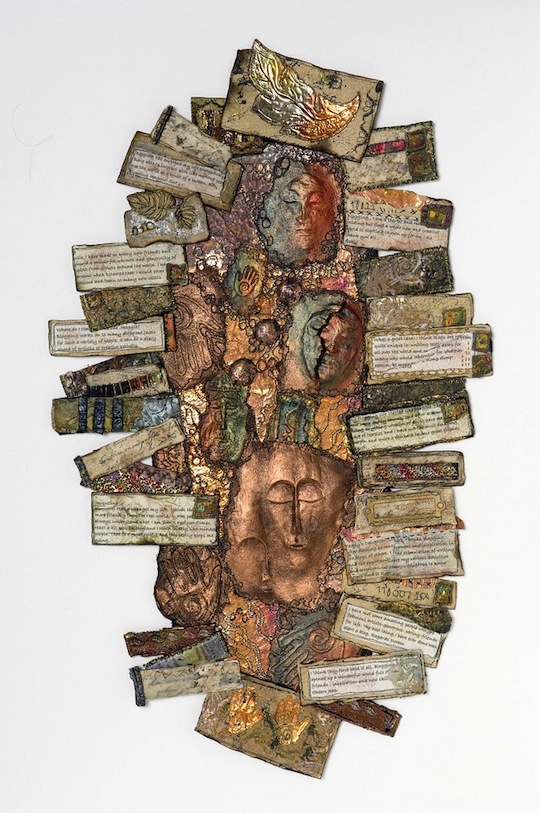
Binary Humanity
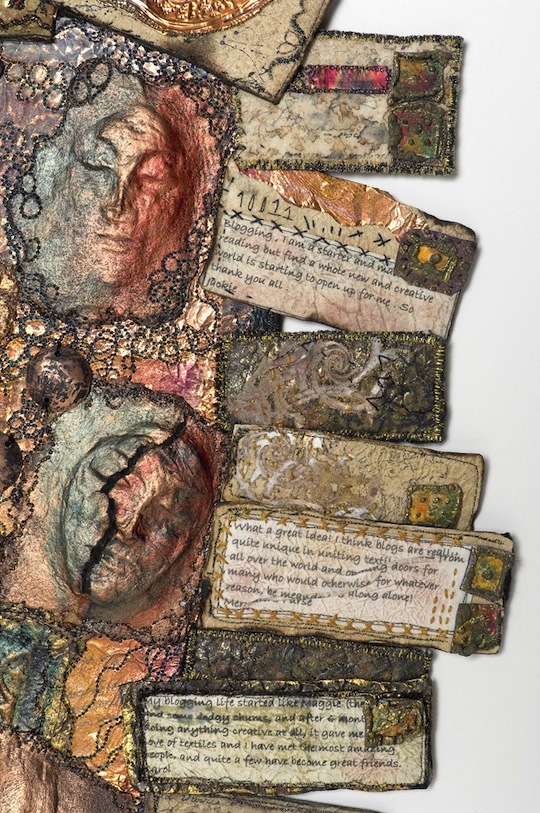
Binary Humanity (detail)
I still use the computer for design, I blog, use Facebook and some of my best mates are people I’ve never met face to face. How weird is that?
The following images show work from my series ‘A Brief History of Wall-painting’completed for an exhibition. I love all forms of wall painting and this series looked at some paintings in chronological order. This one was based on photographs taken in Australia, printed on paper which was crumpled, oiled, stencilled and stitched.

Wall 1
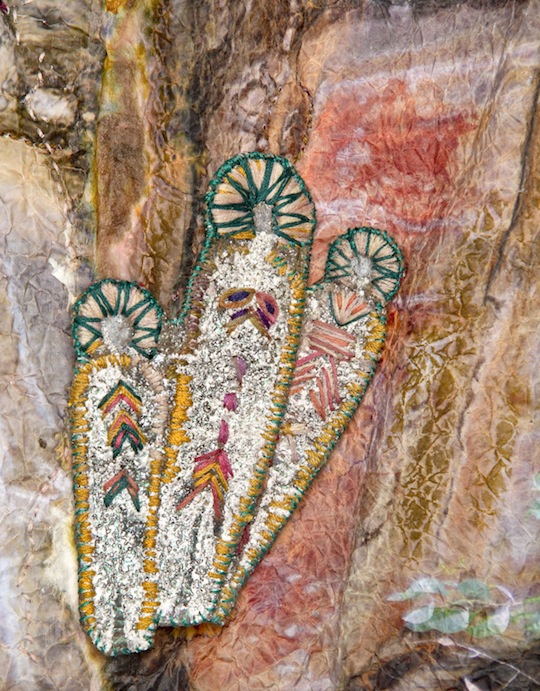
Wall 1 (detail)
The following images show the graffiti panel in this series. Crumpled, oiled paper with gesso was
textured to resemble an old wall. Graffiti was applied and then lettering was stitched on my
computer aided machine to add the words ‘Mag the Tag’. I had fun with this piece.

Wall 2
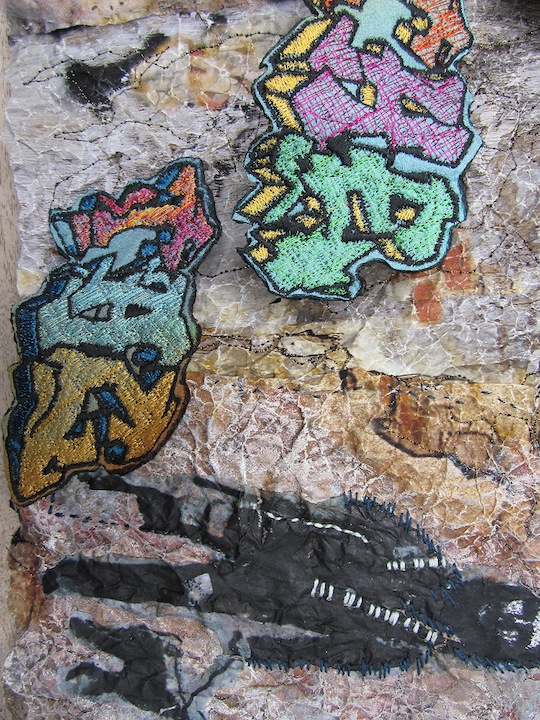
Wall 2 (detail)
You can find more about Maggie on her blog www.magstitch.blogspot.com or visit Workshop on the Web
The next d4daisy book is out in late November 2013. ‘Approaches to Stitch: Six Artists’ features the work of six of the best textile and mixed media artists.
| More useful books for textile artists by Maggie Grey | |
|---|---|
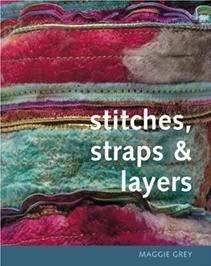 |
|
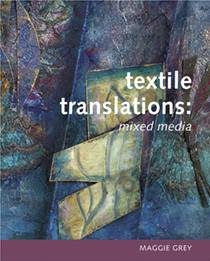 |
|
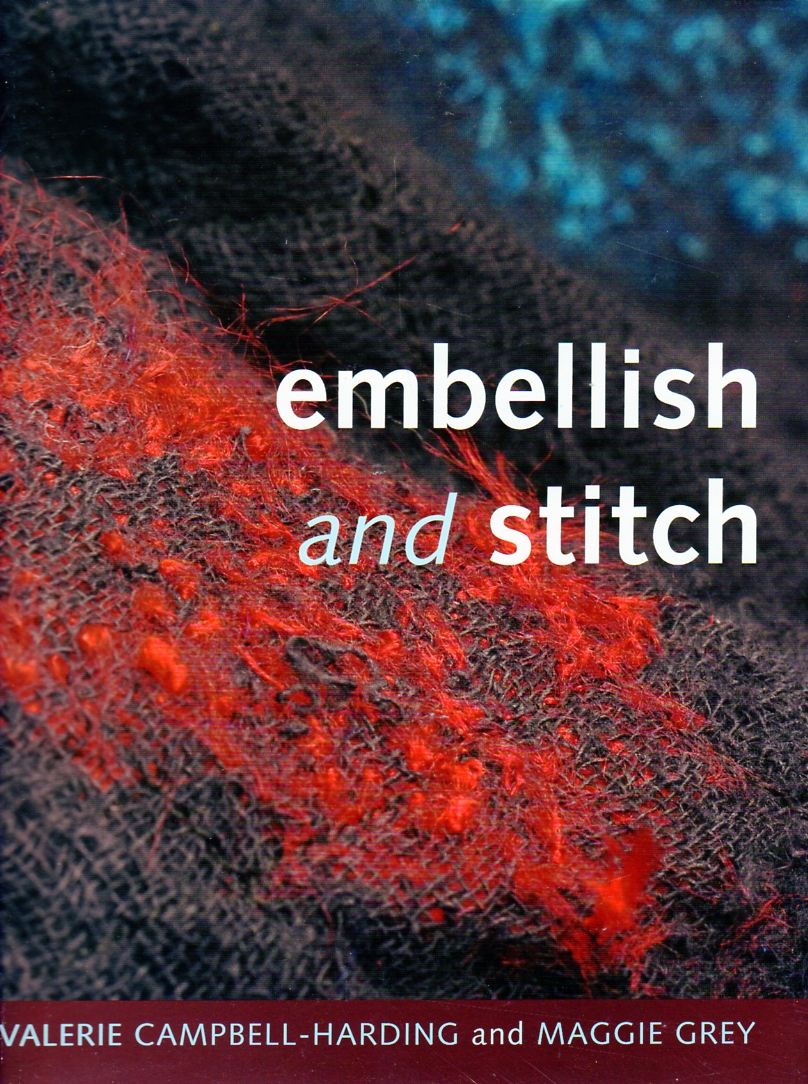 |
Embellish and Stitch |
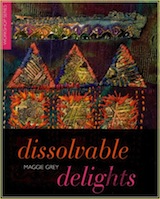 |
Dissolvable Delights
|
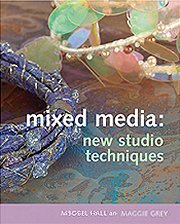 |
|
If you’ve enjoyed this insight into the work of Maggie Grey and Workshop on the Web why not leave a comment below to let us know.
















I was interested to find out how Workshop on the web came about. A very enjoyable article with lovely images.
Fascinating article Maggie and wonderful samples of work.
It is one thing to have watched this happen from the time of your ‘Embroidery’ days to right now and quite another, and very interesting view of your career such as this, a sort of ‘zoom-in’ on the highlights. We MUST have you with us, showing us the way for many, many more years, Maggie! I am so delighted to have a piece of your work hanging on the wall of my studio, and even more so to be one of your online mates. 😉 Someday, we must meet! Wabs
Great Article
Great article. Very interested to hear how WOW was created.
Maggie Grey has always been a favourite her work is inspiring & beautiful & Maggie is incredibly generous to share her talents & skills so widely…I have most of her books & Val Campbell Harding’s also…sending thanks & Best wishes from Nth Qld Australia
I attended one of Maggies and Val Campbell Hardings computer workshops at Urchfont Manner, and remembering having to take the computer work tower and key board etc. It was a fabulous five days, learnt so much, the food was terrific as well. I still have an on going interest in Computer textiles to this day. The world is a better place thanks to such inspiring people.
Thank you for explaining how the WoW world began. Love reading your books and also your blog – long may they both last.
Thank you for your comments and kind words Mary. We really appreciate your support!
Hello Maggie, I am getting older by the minute and finding stairs more difficult so I have had to cut down on my workroom. Turning out has been terrible but one of the items I found was a collection of CTDG magazines ending in July 2008. I do not want to ditch them and wonder if you know of anyone who would like them.
This does not mean I have given up textile exploration, just that I am not now so adventurous!
Wonderful to know that you are still involved.
Best wishes, Dee